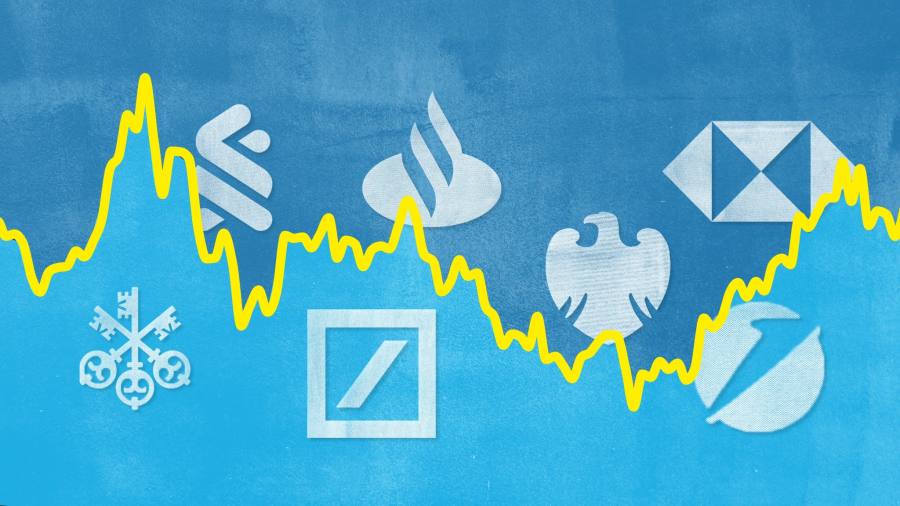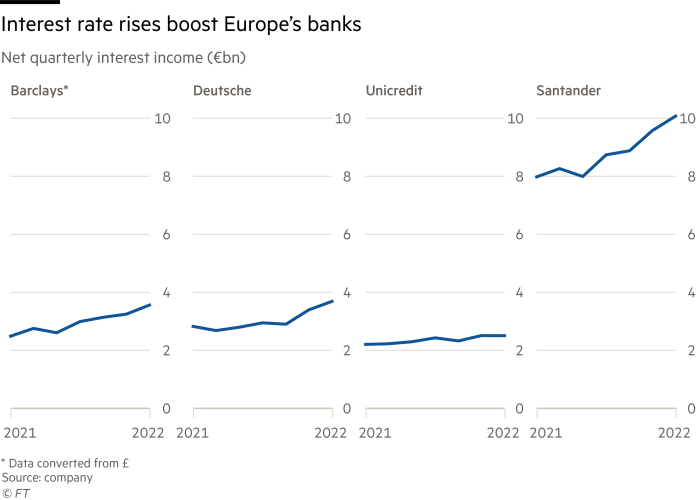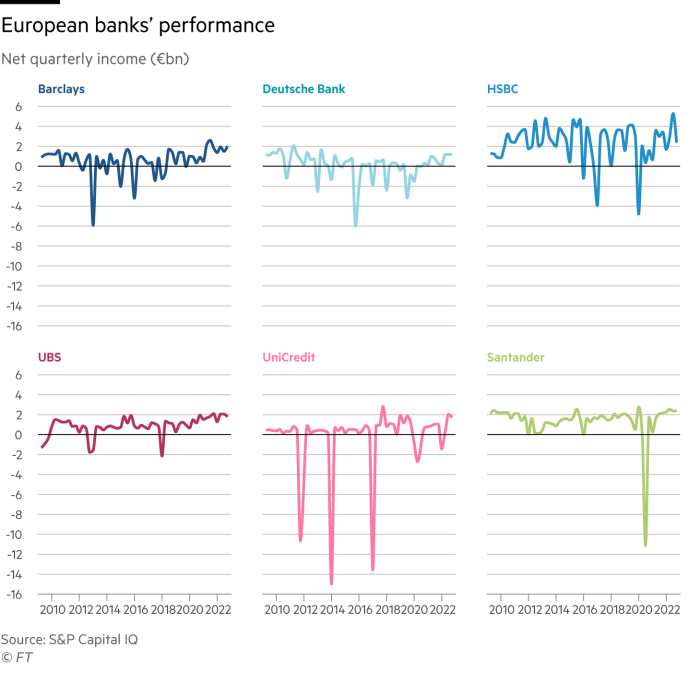
For the first time since the financial crisis, European bank bosses are beginning to enjoy the benefits of rising interest rates on their profit margins.
HSBC, UBS, Barclays, Deutsche Bank, Santander, UniCredit and Standard Chartered all reported better than expected third-quarter results this week, boosted by central bank interest rate raises — with more increases on the way.
After more than a decade of lagging US rivals on profitability and share price performance, European banks are finally reaping the gains of rising rates.
“The banking industry in Europe is coming back from a period of depressed profitability, reflecting the interest rate environment that we’ve been living in since 2014 and before,” said James von Moltke, Deutsche Bank chief financial officer, on Wednesday.
However, despite the fillip from rising rates, European banks are also facing darkening economic conditions — with energy costs soaring more quickly than in the US — and the likelihood of surging defaults.
Meanwhile, the prospect of higher bank profits has also put cash-strapped governments on alert, with several considering windfall taxes on European lenders, sending a chill through the sector.
“The idea that there’s sort of excess profits being earned in an industry that is trying to get back to its cost of capital is one that I would certainly dispute, regardless of the political impetus that’s out there,” said von Moltke.
Deutsche Bank is on course for its biggest annual profits since before the financial crisis and has been one of the biggest beneficiaries of rising interest rates — which generate more net interest income, the difference between what banks receive from borrowers and pay out to depositors.
The benefits are felt strongest by lenders with big retail and corporate banking operations.
Asia-focused Standard Chartered, which is headquartered and listed in London, reported pre-tax profit of $1.4bn for the third quarter on Wednesday, up 40 per cent from a year earlier on a constant currency basis and beating analyst estimates of $1.1bn.

Interest rate rises in StanChart’s main markets drove net interest income to more than $2bn, with the bank reporting its highest quarterly operating income for several years.
“Roughly half the growth that we’ve had so far is coming from interest rate increases, which we’ve also positioned well for in terms of our deposit base,” said chief executive Bill Winters.
HSBC also comfortably beat analyst estimates on Tuesday on the back of rising rates and upgraded its guidance for net interest income to $32bn this year and at least $36bn the next.
After more than a decade of low and even negative interest rates, central banks have begun raising them to tackle surging inflation, which rose above 10 per cent in the UK this month.
Bank of England interest rates have risen to 2.25 per cent, from 0.1 per cent last year, while bank analysts expect the ECB to raise interest rates from 0.75 per cent to 2.5 per cent next year.
Italy’s second-biggest bank, UniCredit, reported a record €1.7bn profit on Tuesday for the three months ending in September, higher than the €1bn analysts had expected, which chief executive Andrea Orcel said was partly down to central bank hikes.
Another bright spot for European lenders with large investment banking arms was fixed income, currencies and commodities (FICC), which had a strong quarter, following a trend set by the US banks that reported earlier in the month.

Among US banks, aggregate investment banking revenues for the third quarter were $32bn, down 16 per cent compared to a year earlier. FICC revenues rose 23 per cent over the same period, while equities revenues were down 13 per cent and advisory revenues down 54 per cent.
Deutsche Bank reported its strongest third quarter since before the financial crisis, boosted by its fixed income-focused investment bank.
Revenues at the German lender’s fixed income business were €2.2bn, 38 per cent higher than a year earlier and comfortably above analyst estimates.
Barclays also posted strong results in its FICC business, with a 63 per cent rise in dollar revenues over the year to £4.7bn.
“Barclays significantly surpassed FICC revenue expectations for the third consecutive quarter, once again materially outperforming the US peers in terms of year-on-year growth,” said Citigroup analyst Andrew Coombs.
US banks have traditionally outperformed their European rivals in fixed income due to their bigger teams and the deeper capital markets in North America.
CS Venkatakrishnan, Barclays chief executive, said FICC was the “standout” market for the bank. “Clearly, the volatility across global markets provides a tailwind for this business as we help clients manage their risk,” he added.
The biggest drag for European investment banks in the third quarter, however, was their advisory arms, which have struggled to generate revenues along with their US rivals in a listless dealmaking market this year.
UBS, which is primarily a wealth manager, suffered a 19 per cent drop in investment banking revenues to $2bn, with revenues at the group’s global banking division, which includes its advisory and capital markets business, falling 58 per cent.
The slump in dealmaking is expected to lead to large job culls at Wall Street lenders, though European banks do not plan such severe cuts, according to executives.
The biggest outlier is Credit Suisse, which publishes third-quarter results on Thursday. It is expected to report a loss for the quarter, alongside details of a radical restructuring of the business.
The new strategic plan — its second in the space of a year — is expected to include the sale of several parts of the business, such as its profitable securitised products business, as well as up to 5,000 job cuts.